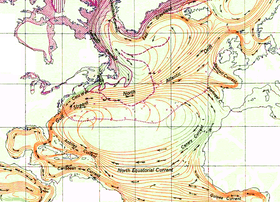North Atlantic Gyre

The North Atlantic Gyre, located in the Atlantic Ocean, is one of the five major oceanic gyres. It is a circular system of ocean currents that stretches across the North Atlantic from near the equator almost to Iceland, and from the east coast of North America to the west coasts of Europe and Africa.
The currents that compose the North Atlantic Gyre include the Gulf Stream in the west, the North Atlantic Current in the north, the Canary Current in the east, and the Atlantic North Equatorial Current in the south. This gyre is particularly important for the central role it plays in the thermohaline circulation, bringing salty water west from the Mediterranean Sea and then north to form the North Atlantic Deep Water.
This gyre is similar to the North Pacific Gyre in the way it traps man-made marine debris in the North Atlantic Garbage Patch, similar to the Great Pacific Garbage Patch in the North Pacific.[1]
The North Atlantic Gyre forms the Sargasso Sea, noted for its still waters and dense seaweed accumulations.
Seasonal variability
As with many oceanographic patterns, the North Atlantic Gyre experiences seasonal changes. Stramma and Siedler (1988) determined that the gyre expands and contracts with a seasonal variance; however, the magnitude of volume transport does not seem to change significantly. During the Northern Hemisphere winter season, the gyre follows a more zonal pattern; that is, it expands in the east-west direction and thins in the north-south direction. As the seasons move from winter to summer, the gyre shifts south by a few degrees latitude. This occurs concurrently with the displacement of the northeastern part of the gyre. It has been concluded that zonal deviations within the gyre remain small while north and south of the gyre they are large.[2]
Data collected in the Sargasso Sea region in the western part of the North Atlantic Gyre has led to analytical evidence that the variability of this gyre is linked to wintertime convective mixing. According to Bates (2001), a seasonal variation of 8-10 °C in surface temperature occurs alongside a fluctuation in the mixed layer depth between the Northern Hemisphere winter and summer seasons. The depth rises from 200 meters in winter to about 10 meters in summer. Nutrients remain below the euphotic zone for most of the year, resulting in low primary production. Yet during winter convective mixing, nutrients penetrate the euphotic zone, causing a short-lived phytoplankton bloom in the spring. This then lifts the mixed-layer depth to 10 meters.
The changes in oceanic biology and vertical mixing between winter and summer in the North Atlantic Gyre seasonally alter the total amount of carbon dioxide in the seawater. Interannual trends have established that carbon dioxide concentrations within this gyre are increasing at a similar rate to that occurring in the atmosphere. This discovery concurs with that made in the North Pacific Gyre. The North Atlantic Gyre also undergoes temperature changes via atmospheric wave patterns. The North Atlantic Oscillation (NAO) is one such pattern. During its positive phase, the gyre warms. This is due to a weakening of the westerly winds, resulting in reduced wind stress and heat exchange, providing a greater period of time for the gyre water temperatures to rise.[3]
Lead contamination
Collections of aerosols, marine particles, and ocean water in the North Atlantic Gyre from 1990-1992 have led to measurements in lead isotope ratios. These measurements exceed those associated with atmospheric pollution carried from Europe by the trade winds, implying that the majority of lead contamination in the gyre in the early 1990s was primarily caused by American emissions. The surface layers of the Sargasso Sea were used to estimate the lead isotopic concentrations. 42-57% of the lead isotope concentrations result from American industrial and automotive contamination, despite the reduction in the production and use of leaded gasoline in the United States. However, lead concentrations from measurements made after 1992 show a decrease in the amount of lead contamination.[4]
See also
References
- ↑ Lavender Law, Kara; S. Moret-Fergusen; N. Maximenko; et al. (2010). "Plastic accumulation in the north atlantic subtropical gyre". Science. 329 (5996): 1185–8. doi:10.1126/science.1192321. PMID 20724586.
- ↑ "Seasonal changes in the North Atlantic subtropical gyre". Journal of Geophysical Research. 1988. Retrieved 5 December 2013.
- ↑ "Interannual variability of oceanic CO2 and biogeochemical properties in the Western North Atlantic subtropical gyre". Deep-Sea Research Part II: Topical Studies in Oceanography. 2001. Retrieved 5 December 2013.
- ↑ "Isotopic evidence of pollutant lead transport from North America to the subtropical North Atlantic gyre". Geochimica et Cosmochimica Acta. 1997. Retrieved 7 December 2013.